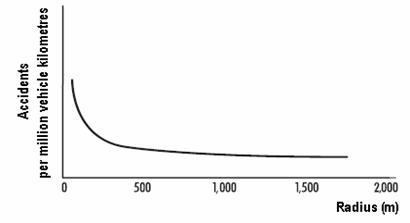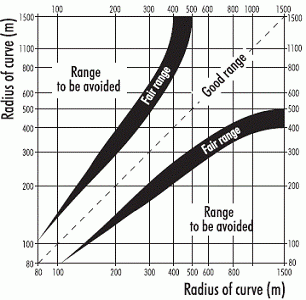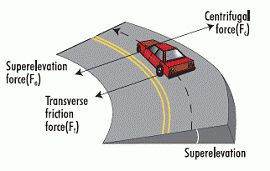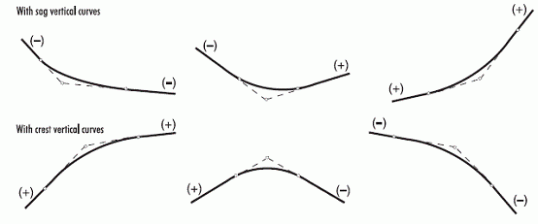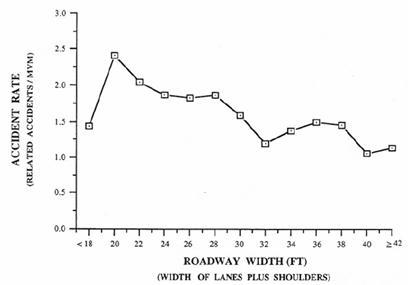Getting initial safety design principles right
Getting initial safety design principles right
Road safety analysis has contributed to the international experience on identifying relationships among various road design elements and accident risk, and best practices towards improving road safety. In the following paragraphs, road safety issues related to road characteristics and road infrastructure features are discussed. The issues presented are based on a synthesis of the international literature. It should be noted that the following sections are a synopsis of the international experience and practice, and they are not exhaustive on the effect of road design elements on road safety.
Road sections
Road design optimization aims at the selection of geometric design parameters resulting in a road environment that is "non-surprising", in the sense that users are not faced with unexpected situations, as well as "forgiving", in the sense that users' mistakes can be, if not avoided, corrected. The selected design speed, on which road alignment parameters are determined, needs to be realistic and compatible to the expected operational speed. Moreover, the design speed should be in accordance to the type and functional requirements of the road, and compatible to the roadway environment.
In the following paragraphs, various road design elements are examined and assessed, including horizontal and vertical alignment and their combination, as well as cross-sections characteristics.
Horizontal alignment
The horizontal alignment of a road comprises straight lines, circular curves (with a constant radius), and transition curves, whose radius changes regularly to allow for a gradual transfer between adjacent road segments with different curve radii. Various sequences of these three basic components are possible (Figure 1). The main objective of horizontal alignment should be to ensure consistency and uniformity along the alignment, in order to avoid the creation of sections demanding an important adjustment of travel speed. In general, uniformity on the alignment is achieved by avoiding steep changes of alignment features.
Figure 1 Sequence of horizontal alignment components (PIARC 2003)
Several studies have been conducted to estimate the accident risk in horizontal curves. Their main conclusions are:
On horizontal curves, because of the limited sight distance and the increased probability of skidding, increased accident rates are observed. The majority of accidents on horizontal curves concern single vehicle run-off accidents and head-on collisions [86].
Horizontal curves of low radii lead to road safety problems, while the related risk rates increase significantly for radii < 200 m [73]. Research results show that the number of road accidents tends to increase when the radii of horizontal curves decreases [41] [36]. The general form of this relationship, as confirmed from an exhaustive literature review by Hauer [39] is presented in the following Figure 2. Moreover, a large central angle (i.e. the angle subtended at the centre of the circular curve) is associated with sharp horizontal curves in having insufficient sight distance. To ensure a consistent design, designers should used small angles with sufficient sight distance [3].
Figure 2 Effect of horizontal curve radius on accident risk (Hauer:2000 PIARC 2003)
According to the above, transition curves (clothoides) are defined as a transition from a tangent (i.e. straight) section to a circular curve (i.e. the point where the radius of curvature reaches its minimum). In a transition curve, the road will gradually curve more and more. The design standards recommend that a transition curve should be constructed in horizontal curves, designed as a clothoide. A clothoide is a curve where the radius of curvature decreases linearly as a function of the arc length. When driving in this type of curve, the driver will follow the curve by turning the wheel at a constant rate in the direction of the curve. Consequently, the need for abrupt movements, in order to negotiate the curve, is eliminated [19].
An important additional safety effect concerns the frequency of horizontal curves along the alignment. It has been shown that the presence of a single curve can be a risk factor, especially for low radii. In the following Table1, it is demonstrated that if a sharp curve is located on a road with low average curvature (i.e. long preceding tangents), accident risk increases significantly [56] [39]. Moreover, accident risk increases significantly with curve frequency [73].
|   | Accidents per million vehicle kilometres for preceding tangent length (m) | |||||||
|---|---|---|---|---|---|---|---|---|
| Radius (m) | 25 | 75 | 125 | 175 | 300 | 500 | 800 | 1200 |
| 126 | 0.33 | 0.36 | 0.48 | 0.41 | 0.53 | 0.25 | 0.55 | 0.64 |
| 286 | 0.15 | 0.21 | 0.20 | 0.26 | 0.23 | 0.20 | 0.23 | 0.31 |
| 489 | 0.22 | 0.17 | 0.77 | 0.22 | 0.11 | 0.21 | 0.05 | 0.17 |
| 812 | 0.21 | 0.07 | 0.12 | 0.06 | 0.15 | 0.12 | 0.08 | 0.10 |
Table 1. Accident risk breakdown by curve radius and preceding tangent length (Matthews, Barnes, 1988)
Horizontal alignment sequences should reduce operating speed variations along a route. A sharp (i.e. lower radius) curve after a long tangent or after a sequence of significantly more gentle (i.e. higher radius) curves may increase accident risk. The transition to sharper curves should therefore be carried out by a progressive reduction of radii along sequential curves, following the respective regulations on radius sequences [11] [83]. Graphs were drawn up to indicate the design quality of various possible curve radii sequences, as shown in Figure 3 below.
Figure 4 Tuning radii in curve sequences (Lamm et al 1999, RAS-L 1995)
Additionally, research results show that the proportion of vehicles run-offs at the external side of the curve increases when radius decreases, whereas on tangent sections around two out of three run-offs occur towards the right, probably due to vehicles attempting to avoid collision with vehicles coming from the opposite traffic stream [82].
Superelevation is a road's transverse incline toward the inside of a horizontal curve. It slightly reduces the friction needed to counter the centrifugal force and increases riding comfort. The laws of physics specify the relationship between speed, radius, superelevation and side friction. These laws can be captured by a simple mathematical formula, which can be used for design. As a result, the maximum speed in a curve increases with superelevation. Accordingly, using the maximum allowed superelevation and a "conservative" value for the side friction for various design speeds, one can compute the lowest "safe radius" [36] [46].
A transition zone between the tangent and the horizontal curve is needed to gradually introduce the superelevation. Dunlap, found the number of accidents on wet pavements to be abnormally high in curves with a superelevation of less than 2%. Zegeer report that improving the superelevation reduces the number of accidents by 5 to 10%.
Figure 5 Horizontal curve system of force and superelevation (PIARC 2003)
On two-way two-lane roads, it is important to ensure sufficient length and sight distance for overtaking. It is recommended that values of curve radii, for which it is not clear whether there is possibility for overtaking, are avoided.
Vertical alignment
The vertical alignment of a road consists of straight segments (levelled or inclined) connected by sag or crest vertical curves. Combinations of these elements create various shapes of road profiles (Figure 5). The longitudinal section of a road includes sections with constant gradient and the related transition curves.
Figure 6 Examples of vertical alignment (PIARC 2003)
Several studies have been conducted to estimate the accident risk in vertical curves. Their main conclusions are:
On sections with high gradient, safety problems may occur from speed differentials between passenger cars and heavy vehicles (e.g. heavy vehicles idling on upgrade sections), as well as vehicles braking on downhill sections (e.g. increases in braking distances and possibility of heavy vehicle brake overheating). It should be noted that road sections with gradients higher than 4% tend to present an increased road accident risk [88] [10].
On crest curves of the longitudinal section, because of the limited radius of the transition curve, the available sight distance may not be sufficient for safe overtaking. It is important that values of the radius, for which appropriate overtaking distances are not assured, are avoided.
On sag curves of the longitudinal section, critical parameters include the range of vehicle lights, the presence of bridges or other constructions limiting sight distance. Other elements to be considered are water accumulation and accelerated erosion of shoulders due to water run-off.
A study on vertical curves has shown higher accident rates for sag curves than for crest curves. Moreover, according to a study [57], accident rates are higher when entering the curve than when leaving the curve, for both crest and sag curves.
The combined effect of road gradient and vertical curvature on accident risk was also examined by Matthews and Barnes [56]. The results were consistent with previous research and indicated that accident rates at sags and crests are very different and should not be considered similar. Moreover, it appears that the accident rate increases with the gradient on downhill sections (a 10% increase in accidents for every 1% increase of the downhill gradient is indicated), while it is not clear whether the accident rate increases with the uphill gradient. Finally, it is clear that higher radius vertical curves have a smaller accident rate than lower radius vertical curves [36].
Combination of horizontal and vertical alignment
An inefficient combination of horizontal and vertical alignment may lead to road safety problems, even when the horizontal and the vertical alignment are separately correct and according to guidelines. Poor coordination of horizontal and vertical alignments can create locations where the available sight distance drops below the required sight distance [35].
In particular, the coincidence of a horizontal and a crest vertical curve may, under certain conditions, lead to significant limitation of the available sight distance and prevent the prompt perception of the curve. Accordingly, the coincidence of a horizontal and a sag vertical curve may create a false impression of the degree of curvature (i.e. the horizontal curve may seem to have a higher radius than the actual), and may contribute to increased accident rates [81] [42].
Effectiveness of horizontal and vertical alignment elements
Improving the alignment and sight conditions of a road makes it easier to plan driving, because the path of the road and other road users are more easily visible. Another objective is to increase mobility, by improving horizontal and vertical curves as well as gradients, which lead to significant reductions in speed. The following results are a synthesis of the international experience, as presented in the "Handbook of Road safety Measures" [19].
Cross-sections
This section summarizes the known relationships between accident experience and cross-sectional roadway elements. Such elements include lane width, shoulder width, shoulder type, roadside features, median design, and others [109].
Lane width should be examined in relation to the expected operational speed. Very narrow lanes cause problems, especially as far as heavy vehicles are concerned. In general, increasing lane width results to a certain improvement of road safety. However, very large lanes may lead to important increase of travel speeds.
Research results have shown that accident risk decreases when lane width increases. Results for two-lane roads indicated that increasing lane width beyond 3,3 m may not be justified in terms of road safety benefit [45][42][36].
The implementation of a shoulder (especially paved) or an emergency lane also contribute to improved road safety on interurban roads [67]. Research results indicate that very narrow shoulders (e.g. <0,5 m) or very wide emergency lanes (e.g. >3 m), which may end up being used by drivers as regular lanes in increased traffic, are related to increased accident rates [42].
Moreover, research results have shown that accident risk decreases when shoulder width increases. Results for two-lane roads indicated that increasing shoulder width beyond 2,5 m may not be justified in terms of road safety benefit [45][105].
Figure 7 Effect of roadway (lane plus shoulder) width on accident risk of two lane low volume rural roads (1 ft=0,305 m) (Zegeer et al 1994)
The construction of a median on interurban roads may contribute significantly in reducing the number and severity of road accidents. On roads with more than two lanes, the implementation of a median leads to significant reduction of the number of road accidents. However, accidents still occur, because of drivers crossing the median and entering the opposite traffic stream. The number of these accidents decreases when median width increases. For median width equal to 12 m, only 15% of vehicles that enter the median also enter the opposite traffic stream [29].
Moreover, it has been found that an important decrease of the reduction rate of accident risk is observed for median width beyond 6-7 m On single carriageway roads (undivided roads), it is recommended to have sufficient cross-section width, to allow for overtaking without entering the opposite traffic stream. Additionally, on uphill sections, where heavy vehicles have low travel speeds, it is recommended that additional idling lanes are foreseen. The locations where the road cross-section changes (including transition from dual to single carriageway road, reduction of the number of lanes, reduction of lanes/shoulders width etc.) are also considered to be critical for road safety. On these locations, satisfactory sight distance, sufficient transitory length and appropriate signalization are required.
On tangent sections cross-slopes mainly serve for the drainage of the carriageway. The lower the transverse gradient, the more increased is the probability of water concentration on the carriageway, and consequently the higher the probability of accidents due to skidding, as shown in Figure 7. On horizontal curves, it is important to select appropriate superelevation. The lack of appropriate cross-slope/superelevation may increase accident risk, especially when combined with insufficient pavement skid resistance.
Cross-section improvements
Improving the cross-section of a road is intended to give all road users increased safety margins by making the road wider and separating the carriageways, and increase mobility by increasing the capacity of the road. Cross-section improvements include the following measures [19]:


